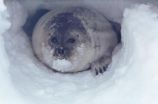(Press-News.org) As sea ice in the Arctic continues to shrink during this century, more than two thirds of the area with sufficient snow cover for ringed seals to reproduce also will disappear, challenging their survival, scientists report in a new study.
The ringed seal, currently under consideration for threatened species listing, builds caves to rear its young in snow drifts on sea ice. Snow depths must be on average at least 20 centimeters, or 8 inches, to enable drifts deep enough to support the caves.
"It's an absolute condition they need," said Cecilia Bitz, an associate professor of atmospheric sciences at the University of Washington. She's a co-author of the study, published in the journal Geophysical Research Letters.
But without sea ice, the platform that allows the snow to pile up disappears, ultimately reducing the area where the seals can raise their pups.
Bitz typically focuses on studying the area and thickness of sea ice. "But when a seal biologist telephoned and asked what our climate models predict for snow depth on the ice, I said, 'I have no idea,'" she said. "We had never looked."
That biologist was co-author Brendan Kelly of the National Science Foundation and he was curious about the snow depth trend because he was contributing to a governmental report in response to the petition to list the seals as threatened.
The researchers, including lead author and UW atmospheric sciences graduate student Paul Hezel, found that snowfall patterns will change during this century but the most important factor in determining snow depth on the ice will be the disappearance of the sea ice.
"The snowfall rate increases slightly in the middle of winter by the end of the century," Hezel said.
However, at the same time sea ice is expected to start forming later in the year than it does now. The slightly heavier snowfall in the winter won't compensate for the fact that in the fall -- which is also when it snows the heaviest -- snow will drop into the ocean instead of piling up on the ice.
The researchers anticipate that the area of the Arctic that accumulates at least 20 centimeters of snow will decrease by almost 70 percent this century. With insufficient snow depth, caves won't hold up.
Other climate changes threaten those caves, too. For instance, the snow will melt earlier in the year than it does now, so it's possible the caves won't last until the young seals are old enough to venture out on their own. In addition, more precipitation will fall as rain, which soaks into the snow and can cause caves to collapse.
The research is important for more than just the ringed seals. "There are many other reasons to study snow cover," Hezel said. "It has a huge thermodynamic impact on the thickness of the ice."
Snow on sea ice in fall and winter acts like a blanket that slows the release of heat from the relatively warm ocean into the atmosphere. That means deeper snow tempers sea ice growth.
In the spring, snow has a different impact on the ice. Since snow is more reflective than ice, it creates a cooling effect on the surface. "So the presence of snow helps sustain the icepack into spring time," Hezel said.
To produce the study, the scientists examined 10 different climate models, looking at historic and future changes of things like sea ice area, precipitation, snowfall and snow depth on sea ice. The resulting prediction for declining snow depth on sea ice this century agreed across all of the models.
The new research comes too late to be cited in the report about ringed seals that was written by the National Oceanic and Atmospheric Administration in response to the petition to list the ringed seal as threatened. However, it confirms results that were based on a single model that Bitz provided for the report two years ago. NOAA expects to issue its final decision soon.
INFORMATION:
The UW scientists on this study were funded by the Office of Naval Research.
Images and additional information are available on UW Today: http://www.washington.edu/news/2012/09/17/shrinking-snow-depth-on-arctic-sea-ice-threatens-ringed-seal-habitat/
For more information, contact Hezel at phezel@atmos.washington.edu or 206-321-5737 or Bitz at 206-543-1339, bitz@atmos.washington.edu.
Shrinking snow depth on Arctic sea ice threatens ringed seal habitat
2012-09-18
ELSE PRESS RELEASES FROM THIS DATE:
Sex matters: Guys recognize cars and women recognize birds best
2012-09-18
Women are better than men at recognizing living things and men are better than women at recognizing vehicles.
That is the unanticipated result of an analysis Vanderbilt psychologists performed on data from a series of visual recognition tasks collected in the process of developing a new standard test for expertise in object recognition.
"These results aren't definitive, but they are consistent with the following story," said Gauthier. "Everyone is born with a general ability to recognize objects and the capability to get really good at it. Nearly everyone becomes expert ...
Study: Parole decisions affect rehabilitation incentives
2012-09-18
CHAMPAIGN, Ill. — Long mandatory minimum sentences or strong limits on judicial discretion can counter-productively reduce the incentives of prison inmates to engage in rehabilitative behavior, thereby raising recidivism rates, according to published research co-written by a University of Illinois economics professor.
Dan Bernhardt, the IBE Distinguished Professor of Economics at Illinois, says rehabilitation incentives are maximized when the lengths of prison sentences are neither too short, nor too long.
According to the paper, inmates with short prison sentences ...
International team of physicists makes discovery about temperature in convection
2012-09-18
(Santa Barbara, Calif.) –– An international team of physicists is working to ascertain more about the fundamental physical laws that are at work in a process known as convection, which occurs in a boiling pot of water as well as in the turbulent movement of the liquid outer core of the Earth. The team's new finding specifies the way that the temperature of a gas or liquid varies with the distance from a heat source during convection. The research is expected to eventually help engineers with applications such as the design of cooling systems, for instance, in nuclear power ...
UCI researchers find cause of chemotherapy resistance in melanoma
2012-09-18
Irvine, Calif., Sept. 17, 2012 — Researchers with UC Irvine's Chao Family Comprehensive Cancer Center have identified a major reason why melanoma is largely resistant to chemotherapy.
UCI dermatologist Dr. Anand Ganesan and colleagues found a genetic pathway in melanoma cells that inhibits the cellular mechanism for detecting DNA damage wrought by chemotherapy, thereby building up tolerance to cancer-killing drugs.
Targeting this pathway, comprising the genes RhoJ and Pak1, heralds a new approach to treating the deadly skin cancer, which claims nearly 10,000 U.S. lives ...
Summer Geoscience from GSA Bulletin
2012-09-18
Boulder, Colo., USA – GSA Bulletin papers posted online from 20 July through 14 September 2012 elaborate on geoscience from Algeria, Mexico, Spain, Turkey, Nova Scotia, Switzerland, New Mexico, and the U.S. Rocky Mountains. Topics include tectonics, mineral formation, the Moho, age dating using zircon crystals, the Code of Stratigraphic Nomenclature, atmospheric CO2, and early animal evolution.
GSA Bulletin articles published ahead of print are online at http://gsabulletin.gsapubs.org/content/early/recent. Representatives of the media may obtain complimentary copies of ...
Mayo Clinic researchers identify new enzyme to fight Alzheimer's disease
2012-09-18
JACKSONVILLE, Fla. — An enzyme that could represent a powerful new tool for combating Alzheimer's disease has been discovered by researchers at Mayo Clinic in Florida. The enzyme — known as BACE2 — destroys beta-amyloid, a toxic protein fragment that litters the brains of patients who have the disease. The findings were published online Sept. 17 in the science journal Molecular Neurodegeneration.
Alzheimer's disease is the most common memory disorder. It affects more that 5.5 million people in the United States. Despite the disorder's enormous financial and personal ...
Cystic fibrosis disrupts pancreas two ways in CF-related diabetes
2012-09-18
A new University of Iowa study suggests there are two root causes of a type of diabetes associated with cystic fibrosis (CF). The findings, which already have sparked a clinical trial, may guide development of new treatments or even help prevent diabetes in patients with CF.
Almost half of patients with CF will develop diabetes by age 30 and almost one quarter will develop it in their teens. In addition to the health problems caused by high blood sugar, diabetes also worsens lung disease and increases the risk of dying for people with CF. However, the underlying cause ...
Antibiotic-resistant pathogens persist in antibiotic-free pigs
2012-09-18
Researchers from North Carolina State University have found identical strains of antibiotic-resistant Campylobacter coli (C. coli) in both antibiotic-free (ABF) and conventionally raised pigs. This finding may indicate that these antibiotic-resistant pathogens can persist and thrive in the environment, regardless of antimicrobial usage by pork producers.
Dr. Siddhartha Thakur, assistant professor of population health and pathobiology, had previously found that antibiotic-resistant C. coli, a leading cause of foodborne illness in the U.S., was present in both ABF-certified ...
Why home cities matter, refueling willpower, decision speed and moral character, and more
2012-09-18
New in our journals:
Your city matters: San Francisco v. Boston
Your home city matters for both who you are and how you feel, according to a new suite of studies. In seven studies, researchers examined the history and culture of San Francisco and Boston, as well as surveyed residents (including commuters, college students, and middle-aged residents) of each city. They found that San Francisco showed more emphasis on egalitarianism, innovation, and looser social norms, while Boston emphasizes tradition, community, and tighter social norms. As a result, for Bostonians, ...
Cleveland Clinic study shows vitamin E may decrease cancer risk in Cowden syndrome patients
2012-09-18
Saturday, September 15, 2012, Cleveland: Cleveland Clinic researchers have discovered that vitamin E may prevent cancer in patients with an under-recognized genetic disorder.
Several genetic mutations are known to be present in Cowden Syndrome (CS) – a disease that predisposes individuals to several types of cancers, including breast and thyroid cancers. One type of mutation in the succinate dehydrogenase (SDH) genes may be responsible for cancer development, according to research by Charis Eng, M.D., Ph.D., Hardis Chair and Director of the Genomic Medicine Institute ...




